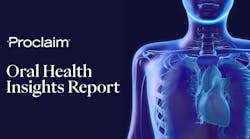MetLife guides
NEW YORK--MetLife, a provider of dental plan administration for nearly 20 million people, has added six new quality resources guides to its dental continuingeducation program.
The resource guides are recognized by the AmericanDental Association and the Academy of General Dentistry.
They include the following courses: 1) Informed Consent Fourth Edition, 2) Managing the Patient with a Worn Dentition, 3) Tobacco Cessation in the Dental Practice, Second Edition, 4) Tooth Root Resorption, Second Edition, 5) Drug Interactions – A Guide for Dentistry, Third Edition, and 6) Electronic Dental Records, Second Edition.
The courses can be completed online for continuing education credits at www.metdental.com.
“MetLife is committed to oral health education, and we continue to expand the list of resources availablein our continuing education program,” said Dr. David Guarrera, DDS, vice president, MetLife Dental Products. "The resources aid in educating the dental community about the latest professional developments in their field to help ensure that patients receive the highest quality treatment and care."
MetLife adds five new quality resource guides
At no charge, these offerings and credits are available to participating dental offices within the MetLife dental preferred provider organization and SafeGuard (a MetLife company) dental health maintenance organization. For a nominal fee, nonparticipating providers can also have access to the program and obtain educational credits.
The new offerings are:
1. Informed Consent, Fourth Edition by Ronald E. Geistfeld, DDS, professor emeritus, University of Minnesota School of Dentistry, and Susan Baker, MHA, director, MetLife Quality Initiatives Program. The guide explains the process of informed consent to the practitioner by illustrating how it should be documented, how it differs among treatments, and under which circumstances it can be delegated. The guide also helps explain how to ensure that the patient is informed and knowledgeable when giving his or her consent.
2. Managing the Patient with a Worn Dentition by Paul A. Hansen, DDS, associate professor and director, prosthodontics, University of Nebraska College of Dentistry, and N. Blaine Cook, DDS, clinical associate professor, Operative Dentistry, and director, Graduate Operative Dentistry, Indiana University School of Dentistry. This guide explains the aspects of managing a patient with a worn dentition. The guide discusses possible causes and walks through the steps necessary to evaluate and create plans for therapy options.
3. Tobacco Cessation in the Dental Practice, Second Edition by Brian C. Muzyka, DMD, MS, MBA, associate professor, and director, Hospital Dentistry, East Carolina University School of Dental Medicine. The guide explains how to determine the stage of a patient’s nicotine dependence. Based on the assessment, the practitioner is then guided in the different ways to assist the patient to create an appropriate withdrawal strategy using behavioral and pharmacotheraputic approaches.
4. Tooth Root Resorption, Second Edition by Karl Keiser, DDS, MS, clinical associate professor of endodontics and past Director of Advanced Education in endodontics, University of Texas Health Science Center at San Antonio. This guide presents an overview of the various types of tooth root resorption, describes suspected resorptive mechanisms and discusses diagnosis, management and associated prognoses. There are detailed sets of radiographs, as well as an easy-to-understand table which outlines the clinical, radiographic, and recommended treatment differences between “internal resorption” and “external resorption.”
5. Drug Interactions – A Guide for Dentistry, Third Edition by Sebastian G. Ciancio, DDS, distinguished service professor and chairman, Department of Periodontics and Endodontics and director, Center for Dental Studies, the State University of New York at Buffalo. The guide reviews selected mechanisms of drug metabolism and describes adverse interactions for drugs that are frequently used in dental practice. Text is suitable for posting in the office to provide the practitioner and staff with easy access to the information.
6. Electronic Dental Records, Second Edition, by Titus Schleyer, DMD, PhD, associate professor and director of the Center for Dental Informatics the University of Pittsburgh. This guide summarizes survey results from dental practitioners regarding their experiences with electronic dental records, and compares EDRs against a composite of dental records from other sources. The guide offers advice and insights for the selection of an EDR and the training necessary for success.
For more information, visit www.metlife.com.
To comment on this topic, go to community.pennwelldentalgroup.com/.

